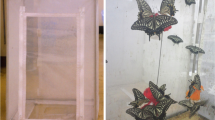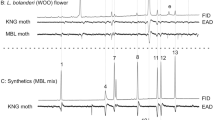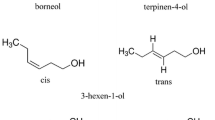Summary
Antennae of femalePapilio butterflies perceive many volatile plant constituents with widely differing, constituent-specific sensitivities. We compared the responses of threePapilio species to volatiles from host and non-host plants to assess species-specificity and the degree of evolutionary conservatism in olfactory responses.
Since previous studies had demonstrated that the polar constituents in odor fromDaucus carota stimulate oviposition behavior inPapilio polyxenes, we collected headspace volatiles fromD. carota, Pastinaca sativa (both Apiaceae) andArtemisia dracunculus (Asteraceae) and separated the polar fraction of these volatiles by gas chromatography. GC-coupled electroantennograms (GC-EAG) were recorded from the speciesPapilio polyxenes, P. machaon hippocrates andP. troilus. In addition, the responses of the three species to five compounds known as generally occurring constituents of plant odor were recorded. The relative sensitivities for these compounds were nearly identical in all threePapilio species. The response spectra to the separated plant volatiles also showed considerable similarities among the species.
From the limited set of GC peaks evoking a response in one of the species, 64% (D. carota), 44% (P. sativa) and 29% (A. dracunculus) also evoked a response in both of the other species. The responses of the two closely related Apiaceae feeders (P. polyxenes, P. m. hippocrates) to volatiles fromD. carota were more similar to each other than was either to the response ofP. troilus, which feeds on Lauraceae. However, this was not true for the responses to volatiles fromP. sativa. The least congruence among the three species was found in the responses to volatiles fromA. dracunculus, a non-host for all of them. The differences and similarities found in the response profiles of the threePapilio species are discussed with respect to evolutionary adaptation to host odor versus evolutionary conservatism in adaptation of olfactory receptors.
Similar content being viewed by others
References
Baur R, Feeny PP (1992) Comparison of electroantennogram responses by females of the black swallowtail butterfly,Papilio polyxenes, to volatiles from two host-plant species. Pp 122–124in Menken SBJ, Visser JH, Harrewijn P (eds) Proceedings of the 8th International Symposium on Insect-Plant Relationships. NL-Dordrecht: Kluwer Academic
Baur R, Feeny P, Städler E (1993) Oviposition stimulants for the black swallowtail butterfly: identification of electrophysiologically active compounds in carrot volatiles. J Chem Ecol 19:919–937
Bernays EA, Chapman RF (1987) The evolution of deterrent responses in plant-feeding insects. Pp 159–173in Chapman RF, Bernays EA, Stoffolano JR (eds) Perspectives in Chemoreception and Behavior. New York: Springer
Bernays EA, Chapman RF (1994) Host-Plant Selection by Phytophagous Insects. New York: Chapman & Hall
Dethier VG (1941) Chemical factors determining the choice of food-plants byPapilio larvae. Am Nat 75:61–73
Feeny P (1991) Chemical constraints on the evolution of swallowtail butterflies. Pp 315–340in Price PW, Lewinsohn TM, Fernandes GW, Benson WW (eds) Plant-Animal Interactions: Evolutionary Ecology in Tropical and Temperate Regions. New York: John Wiley & Sons
Feeny P (1995) Ecological opportunism and chemical constraints on the host associations of swallowtail butterflies. Chapter 2in Scriber JM, Tsubaki Y, Lederhouse RC (eds) Swallowtail Butterflies, Their Ecology and Evolutionary Biology. Gainesville: Scientific Publishers (in press)
Feeny P, Rosenberry L, Carter M (1983) Chemical aspects of oviposition behavior in butterflies. Pp 27–76in Ahmad S (ed.) Herbivorous Insects. New York: Academic
Feeny P, Blau WS, Kareiva PM (1985) Larval growth and survivorship of the black swallowtail butterfly in central New York. Ecol Monographs 55:167–187
Feeny P, Städler E, Åhman I, Carter M (1989) Effects of plant odor on oviposition by the black swallowtail butterfly,Papilio polyxenes (Lepidoptera: Papilionidae). J Insect Behav 2:803–827
Frey JE, Bierbaum TJ, Bush GL (1992) Differences among sibling speciesRhagoletis mendax andR. pomonella (Diptera: Tephritidae) in their antennal sensitivity to host fruit compounds. J Chem Ecol 18:2011–2024
Guerin PM, Städler E (1982) Host odour perception in three phytophagous Diptera — a comparative study. Pp 95–105in Visser JH, Minks AK (eds) Proc 5th Int Symp Insect-Plant Relationships. NL-Wageningen: Poduc
Hansson BS, Van der Pers JNC, Lövquist C. (1989) Comparison of male and female olfactory cell response to pheromone compounds and plant volatiles in the turnip mothAgrotis segetum. Physiol Entomol 14:147–155
Hegnauer R (1962–1992) Chemotaxonomie der Pflanzen: eine Übersicht über die Verbreitung und die systematische Bedeutung der Pflanzenstoffe. Vol. 1–10. CH-Basel: Birkhäuser
Jermy T, Szentesi A, Horváth J (1988) Host plant finding in phytophagous insects: the case of the Colorado potato beetle. Entomol exp appl 49:83–98
Masada Y (1976) Analysis of essential oils by gas chromatography and mass spectrometry. New York: John Wiley & Sons
Masson C, Mustaparta H (1990) Chemical information processing in the olfactory systems of insects. Physiol Rev 70:199–245
Mayer MS, Mankin RW, Lemire GF (1984) Quantitiation of the insect electroantennogram: measurement of sensillar contributions, elimination of background potentials, and relationship to olfactory sensation. J Insect Physiol 30:757–763
Miller JS (1987) Host-plant relationships in the Papilionidae (Lepidoptera): parallel cladogenesis or colonization? Cladistics 3:105–120
Nishida R (1995) Oviposition stimulants of swallowtail butterflies. Chapter 3in Scriber JM, Tsubaki Y, Lederhouse RC (eds) Swallowtail Butterflies: Their Ecology and Evolutionary Biology. Gainesville: Scientific Publishers (in press)
Ohsugi T, Nishida R, Fukami H (1991) Multi-component system of oviposition stimulants for a Rutaceae-feeding swallowtail butterfly,Papilio xuthus (Lepidoptera: Papilionidae). Appl Entomol Zool 26:29–40
Ramachandran R, Khan ZR, Caballero P, Juliano BO (1990) Olfactory sensitivity of two sympatric species of rice leaf folders (Lepidoptera: Pyralidae) to plant volatiles. J Chem Ecol 16:2647–2666
Sachdev-Gupta K, Feeny PP, Carter M (1993) Oviposition stimulants for the pipevine swallowtail butterfly,Battus philenor (Papilionidae), from anAristolochia host plant: synergism between inositols, aristolochic acids and a monogalactosyl diglyceride. Chemoecology 4:19–28
Scriber JM, Lederhouse RC, Hagen RH (1991) Foodplants and evolution withinPapilio glaucus andPapilio troilus species groups (Lepidoptera: Papilionidae). Pp 341–371in Price PW, Lewinsohn TM, Fernandes GW, Benson WW (eds) Plant-Animal Interactions: Evolutionary Ecology in Tropical and Temperate Regions. New York: John Wiley & Sons
Sperling FAH, Feeny P (1995) Umbellifer and composite feeding inPapilio: phylogenetic frameworks and constraints on caterpillars. Chapter 26in Scriber JM, Tsubaki Y, Lederhouse RC (eds) Swallowtail Butterflies: Their Ecology and Evolutionary Biology. Gainesville: Scientific Publishers (in press)
Städler E (1992) Behavioral responses of insects to plant secondary compounds. Pp 45–88in Rosenthal GA, Berenbaum MR (eds) Herbivores, Their Interactions with Secondary Plant Metabolites. Vol. 2. San Diego: Academic Press
Städler E (1994) Oviposition behavior of insects influenced by chemoreceptors. Pp 821–826in Kurihara K, Suzuki N, Ogawa H (eds) Olfaction and Taste XI. Tokyo: Springer
Thompson JN (1988) Variation in preference and specificity in monophagous and oligophagous swallowtail butterflies. Evolution 42:118–128
Topazzini A, Mazza M, Pelosi P (1990) Electroantennogram responses of five Lepidoptera species to 26 general odourants. J Insect Physiol 36:619–624
Van der Pers JNC (1981) Comparison of electroantennogram response spectra to plant volatiles in seven species ofYponomeuta and in the tortricidAdoxophyes orana. Entomol exp appl 30:181–192
Van der Pers JNC (1982) Comparison of single cell responses of antennal sensilla trichodea in the nine european small ermine moths (Yponomeuta spp.). Entomol exp appl 31:255–264
Van Loon JJA, Frentz WH, van Eeuwijk FA (1992) Electroantennogram responses to plant volatiles in two species ofPieris butterflies. Entomol exp appl 62:253–260
Visser JH (1979) Electroantennogram responses of the Colorado beetle,Leptinotarsa decemlineata, to plant volatiles. Entomol exp appl 25:86–97
Visser JH (1986) Host odor perception in phytophagous insects. Annu Rev Entomol 31:121–144
Visser JH, Nielsen JK (1977) Specificity in the olfactory orientation of the colorado beetle,Leptinotarsa decemlineata. Entomol exp appl 21:14–22
White PR, Chapman RF (1990) Olfactory sensitivity of gomphocerine grasshoppers to the odours of host and non-host plants. Entomol exp appl 55:205–212
Author information
Authors and Affiliations
Rights and permissions
About this article
Cite this article
Baur, R., Feeny, P. Comparative electrophysiological analysis of plant odor perception in females of threePapilio species. Chemoecology 5, 26–36 (1994). https://doi.org/10.1007/BF01259970
Issue Date:
DOI: https://doi.org/10.1007/BF01259970




